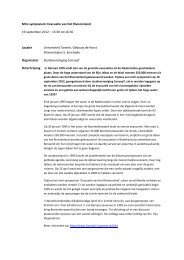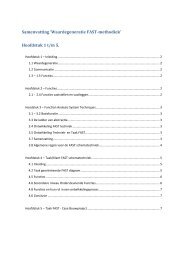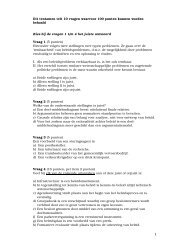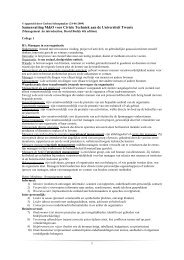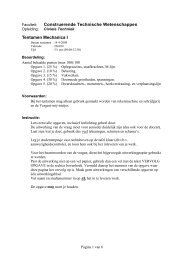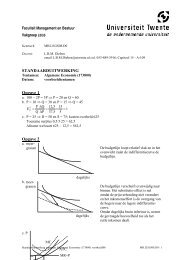Jaargang 19 editie 1 - ConcepT - Universiteit Twente
Jaargang 19 editie 1 - ConcepT - Universiteit Twente
Jaargang 19 editie 1 - ConcepT - Universiteit Twente
Create successful ePaper yourself
Turn your PDF publications into a flip-book with our unique Google optimized e-Paper software.
Figure 2. The world divided: blue – left-driving, red – right-driving (Benjamin D<br />
Esham)<br />
Two thirds of the world, both in<br />
population and in the number of<br />
countries/regions, drive on the<br />
right hand side of the road. These<br />
include continental Europe, the<br />
Middle East, mainland China, and<br />
most countries in the Americas. Almost<br />
all the left-driving countries<br />
are part of the Commonwealth or<br />
used to be a British colony, e.g.<br />
South Africa, India and Australia.<br />
Japan is, however, an interesting<br />
exception. Record has it that Japan<br />
built its first railway under British<br />
assistance. For easy remembrance,<br />
though, compare samurai with<br />
warrior! Other exceptions include<br />
Thailand and Macau, both with<br />
left-driving neighbours. Suriname<br />
also drives on the left.<br />
The opposite of right is left, or<br />
wrong. The next time you meet<br />
an Englishman, feel free to make<br />
the ridicule: “Hey, you drive on<br />
the wrong side of the road, don’t<br />
you?” Be prepared though, of the<br />
reply: “But you sit on the wrong<br />
side of the car.”<br />
Hong Kong, a former British colony,<br />
still retains its rule of driving<br />
on the left. Many cars are registered<br />
with two number plates, one<br />
for Hong Kong and the other for<br />
the bordering mainland China,<br />
where right driving rules apply.<br />
In Shenzhen, the Chinese city next<br />
to Hong Kong, it is not uncommon<br />
to see cars with a driver’s seat on<br />
the curb side! Is it dangerous? Do<br />
these drivers have a high probability<br />
of being involved in traffic<br />
accidents? No such statistics exists.<br />
So it isn’t that difficult to drive<br />
with a ‘wrong’ car.<br />
Sweden switched from driving<br />
on the left hand side of the road<br />
to the right all within one day.<br />
Known back then as Dagen H (H<br />
Day), the day is now mostly referred<br />
to as Högertrafikomläggningen<br />
(right-hand traffic diversion).<br />
On Sunday 3 September <strong>19</strong>67,<br />
at around 5AM, all traffic had to<br />
come to a complete stop and then<br />
carefully change to the right hand<br />
side of the road. Intersections and<br />
one-way roads proved to be most<br />
tricky. Lots of money was spent<br />
Figure 3. Dagen H logo: during the<br />
publicity campaign, the logo was<br />
displayed on various items, including<br />
milk cartons and underwears (Anthony<br />
Ivanoff)<br />
on reconfiguring bus doors.<br />
The importance of having a rule<br />
of the road, no matter left or right,<br />
lies in its necessity. Without it,<br />
traffic will certainly fail. I am sure<br />
that everyone has been in the following<br />
scenario, some more often<br />
than others: you are walking,<br />
suddenly you realise someone<br />
coming in the opposite direction<br />
is right in your way, you make a<br />
step to the left, that person mirrors<br />
you, you make a step to the right,<br />
that person mirrors you again…<br />
Funny, hè?<br />
While the right-driving rule and<br />
right-cycling rule has been well<br />
established, right-walking rule is<br />
still non-existent. So, to save my<br />
dear readers ten seconds per year<br />
and from unlikely romances, I<br />
propose to all of you: step to your<br />
right and pass each other by.<br />
SigNal, S!gnaL, 5i8n41<br />
The side of the road, or the side<br />
of the bathroom. The most frustrating<br />
thing when urgently looking<br />
for a toilet is to get confused<br />
by the sign on the door: is this for<br />
me or the other sex? Standard pictograms<br />
certainly help but oftentimes<br />
you see just words. M-W,<br />
men-women, male-female, ladiesgents,<br />
dames-heren, these are<br />
easy ones. But how about uominidonne?<br />
If that doesn’t fail you, try<br />
muži-ženy.<br />
Language is the highly standardised<br />
medium of our communication.<br />
In a way it is accurate and<br />
efficient. However, more often<br />
than not, we are lost in translation.<br />
There are so many natural languages<br />
in our world (some put the<br />
number to around 6000). No one<br />
would ever claim to understand<br />
even half of them. The lack of a<br />
common language, i.e. a standard<br />
(have you heard of Esperanto?),<br />
does sometimes make things awkward.<br />
Remember though, when<br />
everything fails, you still have one<br />
thing: body language.<br />
<strong>ConcepT</strong>ueel feb. 2010 - 11



